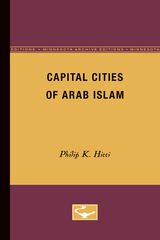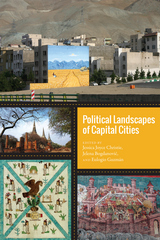2 books about Capital Cities

Capital Cities of Arab Islam
Philip Hitti
University of Minnesota Press, 1973
Professor Hitti, the distinguished authority on the Islamic world, views the highlights of Arab history through the windows of the capital cities where those events occurred. The account focuses on six cities -- Mecca, the religious capital; Medina, the caliphal capital; Damascus, the imperial capital; Baghdad, the intellectual capital; Cairo, the dissident capital; and Cordova, the European capital. The approach is historical rather than geographical, and the book is addressed to the student and the cultured layman rather than the specialist. Tourists to the Middle East and Spain also will find the book especially interesting.The author describes the physical settings of the cities, the primary occupations of the people, and the significant monumental structures. He discusses such modern history of a city as is relevant to the story, but the emphasis is on the period of Arab ascendancy -- roughly, the seventh to the thirteenth century. In addition to Arabic sources, he quotes Europeans’ descriptions where appropriate (such descriptions are rare because Europeans were not allowed in such cities as Mecca and Medina). As he makes clear, the six cities were more than capitals; they left their indelible imprint not only on the subsequent history of the Arabs and other Moslems but on the development of civilization at large.
[more]

Political Landscapes of Capital Cities
Jessica Joyce Christie
University Press of Colorado, 2016
Political Landscapes of Capital Cities investigates the processes of transformation of the natural landscape into the culturally constructed and ideologically defined political environments of capital cities. In this spatially inclusive, socially dynamic interpretation, an interdisciplinary group of authors including archaeologists, anthropologists, and art historians uses the methodology put forth in Adam T. Smith’s The Political Landscape: Constellations of Authority in Early Complex Polities to expose the intimate associations between human-made environments and the natural landscape that accommodate the sociopolitical needs of governmental authority.
Political Landscapes of Capital Cities blends the historical, political, and cultural narratives of capital cities such as Bangkok, Cusco, Rome, and Tehran with a careful visual analysis, hinging on the methodological tools of not only architectural and urban design but also cultural, historiographical, and anthropological studies. The collection provides further ways to conceive of how processes of urbanization, monumentalization, ritualization, naturalization, and unification affected capitals differently without losing grasp of local distinctive architectural and spatial features. The essays also articulate the many complex political and ideological agendas of a diverse set of sovereign entities that planned, constructed, displayed, and performed their societal ideals in the spaces of their capitals, ultimately confirming that political authority is profoundly spatial.
Contributors: Jelena Bogdanović, Jessica Joyce Christie, Talinn Grigor, Eulogio Guzmán, Gregor Kalas, Stephanie Pilat, Melody Rod-ari, Anne Toxey, Alexei Vranich
Political Landscapes of Capital Cities blends the historical, political, and cultural narratives of capital cities such as Bangkok, Cusco, Rome, and Tehran with a careful visual analysis, hinging on the methodological tools of not only architectural and urban design but also cultural, historiographical, and anthropological studies. The collection provides further ways to conceive of how processes of urbanization, monumentalization, ritualization, naturalization, and unification affected capitals differently without losing grasp of local distinctive architectural and spatial features. The essays also articulate the many complex political and ideological agendas of a diverse set of sovereign entities that planned, constructed, displayed, and performed their societal ideals in the spaces of their capitals, ultimately confirming that political authority is profoundly spatial.
Contributors: Jelena Bogdanović, Jessica Joyce Christie, Talinn Grigor, Eulogio Guzmán, Gregor Kalas, Stephanie Pilat, Melody Rod-ari, Anne Toxey, Alexei Vranich
[more]
READERS
Browse our collection.
PUBLISHERS
See BiblioVault's publisher services.
STUDENT SERVICES
Files for college accessibility offices.
UChicago Accessibility Resources
home | accessibility | search | about | contact us
BiblioVault ® 2001 - 2024
The University of Chicago Press









